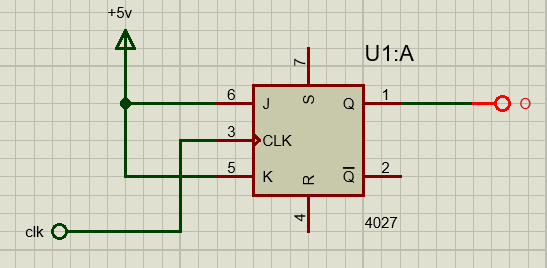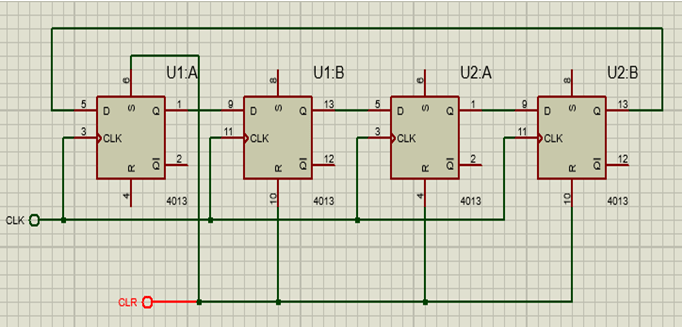This set of Sequential Logic Design Multiple Choice Questions & Answers (MCQs) focuses on “Modeling a Sequential Machine”.
1. Which one of the following best describes a sequential machine?
a) An electronic circuit
b) A logic circuit
c) A Moore machine
d) A mathematical model
View Answer
Explanation: A sequential machine is a mathematical model of a certain type sequential circuit, which has inputs and outputs that can each take on any value from a finite set and are at interest only at certain instants of time. Output depends on both the current as well as the previous input.
2. Which of the following is essential for every sequential model but not for logic circuits?
a) Transmission lines
b) Flip-Flops
c) Memory
d) Switches
View Answer
Explanation: Sequential machine is a mathematical model of a certain type sequential circuit where output depends on both the current as well as the previous input. So we need to store the outputs. That’s why a memory circuit is needed.
3. What will be the output signal of the following sequential circuit?

a) Logic 1
b) Logic 0
c) Toggle
d) Memory state
View Answer
Explanation: It is clear from the diagram that both the inputs to the J-K flip-flop is permanently set to high. From the truth table of JK flip-flop we know that it goes to toggle state if both its inputs are set to high. Hence it will toggle its output between logic 0 and logic 1.
4. If the current state of the following ring counter is 1001 then what will be the state after 2 clock pulses?

a) 1010
b) 0110
c) 0011
d) 1001
View Answer
Explanation: The states of a ring counter changes with every clock pulse and the last output will be fed to the first input. Here the first or initial state was 1001. So after a clock pulse it becomes 1100 as the last 1 is fed to first input and the other values are right shifted. Thus another clock pulse makes it 0110 in the same procedure.
Clock pulse U1:A U1:B U2:A U2:B
0 1 0 0 1
1 1 1 0 0
2 0 1 1 0
5. How can we define the behaviour of a synchronous sequential circuit?
a) Discrete instants of time
b) Continuous instants of time
c) Sampling instants of time
d) Any instant
View Answer
Explanation: Sequential machine is a mathematical model of a certain type sequential circuit where output depends on both the current as well as the previous input. We also need a clock circuit to operate these. Clock inputs are discrete time elements those toggle between on and off. So thus, the time instant is discretized and we can only define the states of the circuits at the on states of the clocks.
6. Which one of the following best describes an asynchronous counter model?
a) Common clock is used
b) Every used flip-flop change state simultaneously
c) Output of the previous flip-flop is set to the clock of the next flip-flop
d) Common clear input is used
View Answer
Explanation: The word “asynchronous” means that no common clock will be used. Hence no common clock is used in this case. Every output is fed to the clock input of the next flip-flop.
Thus, a flip-flop can change its state only when its previous flip-flop changes its state.
7. Which among the following wait statement execution causes the enclosing process to suspend and then wait for an event to occur on the signals?
a) Wait until Clk = ‘1’
b) Wait on x, y, z
c) Wait on clock until answer > 80
d) Wait for 12 ns
View Answer
Explanation: VHDL stands for very high-speed integrated circuit hardware description language. Here, several commands are used to simulate and test the behaviour of any digital circuit. In this case, the wait statement execution causes the enclosing process to suspend and then wait for an event to occur on the signals.
8. Which of the following VHDL design units contain the description of the circuit?
a) Configurations
b) Architecture
c) Entity
d) Library
View Answer
Explanation: VHDL is a very high-speed integrated circuit hardware description language. It has different sections where we define different descriptions. In the architecture section, we define the working description of the circuit.
9. Which of the following describes the structure of a VHDL code correctly?
a) Library Declaration; Configuration; Entity Declaration; Architecture Declaration
b) Library Declaration; Entity Declaration; Configuration; Architecture Declaration
c) Library Declaration; Configuration; Architecture Declaration; Entity Declaration
d) Library Declaration; Entity Declaration; Architecture Declaration; Configurations
View Answer
Explanation: In any VHDL code, the libraries are included first, then an entity is described and then the hardware definition of all the pins and other hardware are defined in the architecture part. Then, all configs are defined.
10. Which one of the following we can’t declare in a process?
a) Variable
b) Bit
c) Constant
d) Integer
View Answer
Explanation: A process consists of sequential statements and signals can be used inside the process. But we can’t declare a signal inside a process. On the other hand, variables can be declared in a process.
11. Which one of the following is not a library unit?
a) Package
b) Entity
c) Bit_Vector
d) Architecture
View Answer
Explanation: Library units are main components of VHDL description. Library units can be of four types – Package, Entity, Architecture and Configuration. Bit vector is not a library unit. Rather it’s a data type in VHDL.
12. Which one of the following is an exponentiation operator in VHDL?
a) ^
b) *
c) **
d) @
View Answer
Explanation: There are several arithmetic operators in VHDL. These are used to perform arithmetic operations in VHDL. Thus the “**” operator is used as an exponentiation operator in VHDL.
13. Which of the following VHDL design units contain the description of the circuit?
a) Architecture
b) Entity
c) Package
d) Configuration
View Answer
Explanation: VHDL (VHSIC-HDL, Very High Speed Integrated Circuit Hardware Description Language) is a hardware description language used in electronic design automation to describe digital and mixed-signal systems such as field-programmable gate arrays and integrated circuits. In the library unit Architecture, the description of the main circuit is described.
Sanfoundry Global Education & Learning Series – Logic Design.
To practice all areas of Logic Design, here is complete set of 1000+ Multiple Choice Questions and Answers.
If you find a mistake in question / option / answer, kindly take a screenshot and email to [email protected]
